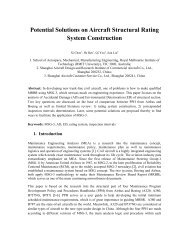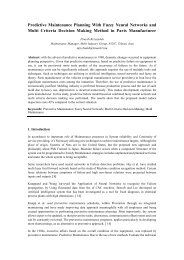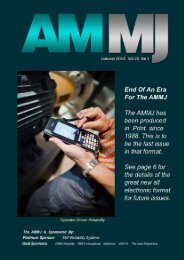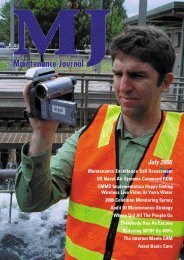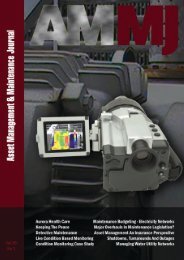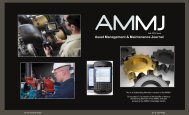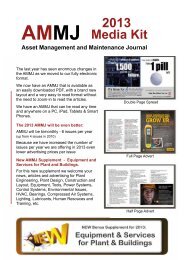July - AMMJ
July - AMMJ
July - AMMJ
You also want an ePaper? Increase the reach of your titles
YUMPU automatically turns print PDFs into web optimized ePapers that Google loves.
<strong>AMMJ</strong><br />
SCADA With Wireless Instrumentation 11<br />
3. Integration:<br />
Managing and debugging<br />
dispersed wireless networks<br />
presents a new level of<br />
complexity to field operators that<br />
could deter them from adopting<br />
wireless instrumentation despite<br />
the exceptional savings. The<br />
wireless network integration<br />
dilemma is more apparent in<br />
SCADA systems. Since wireless<br />
instrumentation networks are<br />
supposed to tie into the same<br />
SCADA infrastructure available<br />
at site to relay valuable operating<br />
data to the SCADA host, having<br />
the ability to manage the<br />
complete infrastructure as one<br />
network becomes essential.<br />
Despite the abundance of tools<br />
to capture, process and analyze<br />
data in the process control<br />
market, ensuring data integration<br />
is still a major problem. Some<br />
SCADA systems even have a<br />
separate historian module that<br />
must be purchased as an addon<br />
to handle the flood of data<br />
as a result of adding wireless<br />
instrumentation networks.<br />
A Coal Seam Gas (CSG) operation in Queensland, Australia, had that problem. CSG, abundant in Queensland,<br />
is the same as natural gas and is collected from more than 700 well sites scattered across the state. Parasyn<br />
Controls, based in Tingalpa, Queensland, is installing Control Microsystems’ SCADAPack controllers at each site<br />
(Figure 2) to collect data, provide local and remote control, report events, and communicate with central SCADA<br />
systems via radio links. Standardizing SCADA and wireless hardware from a single vendor made it simple to<br />
connect the remote sites to the central SCADA systems.<br />
Addressing the Wireless and Data Integration Challenges<br />
A new breed of advanced wireless instrumentation base station radios or gateways is now emerging in the<br />
marketplace. This new generation of gateways integrates both a wireless instrumentation base radio and a long<br />
range industrial radio in the same device.<br />
The integrated long range remote radio is configured as a remote device relaying information to a Master radio at<br />
the main SCADA center. The available two serial ports on the radio are configured to tunnel Modbus polling and<br />
diagnostic data simultaneously to the wireless instrumentation base radio. This allows operators to manage and<br />
diagnose the wireless instrumentation network through the existing long range SCADA infrastructure. Live data<br />
and status information for all field units are displayed in a separate view or integrated in the SCADA host.<br />
On the data integration front, modern SCADA host software offers a fully integrated environment that includes an<br />
integrated and scalable historian to handle more additional data without going through expensive and sometimes<br />
lengthy upgrades. Developing the SCADA screens based on templates allow engineers to add data points easily<br />
and rapidly in their systems.<br />
Conclusion<br />
Figure 2: Coal Seam Gas extraction in Queensland requires local control and<br />
monitoring at 700 wells scattered across the state. The local SCADAPack controllers and<br />
RTUs communicate via radio to centralized SCADA systems.<br />
As the adoption of wireless instrumentation networks increase, users will be faced with a number of challenges<br />
to ensure the reliability, adaptability and tight integration with their existing infrastructure. New RF and antenna<br />
designs help to address reliability and adaptability challenges. This leaves wireless and data integration with the<br />
existing SCADA infrastructure as one of the critical challenges to be resolved. Luckily, hybrid gateways, where<br />
sensor network base radio and long range radio are integrated, allow users to view, manage and diagnose their<br />
dispersed wireless systems from a single point. Similarly, advanced SCADA host software, with an integrated<br />
historian and rapid development environment using templates, can facilitate the integration of new data points<br />
generated by a growing network of wireless sensors.<br />
About the Author<br />
Hany Fouda is the VP of Marketing at Control Microsystems and is responsible for developing and executing global<br />
marketing strategies across the brand portfolio to further drive growth.<br />
Vol 24 No 3




